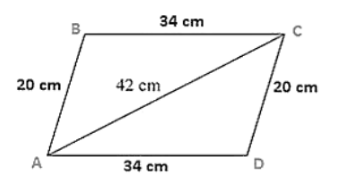The adjacent sides of a parallelogram ABCD measure 34 cm and 20 cm, and the diagonal AC measures 42 cm. Find the area of parallelogram.
The adjacent sides of a parallelogram ABCD measures 34 cm and 20 cm, and the diagonal AC measures 42 cm.
Area of the parallelogram = Area of triangle ADC + Area of triangle ABC
Note: Diagonal of a parallelogram divides into two congruent triangles
Therefore,

Area of the parallelogram = 2 × (Area of triangle ABC)
Now, for area of triangle ABC
Perimeter = 2s = AB + BC + CA
2s = 34 cm + 20 cm + 42 cm
s = 48 cm
By using Heron's Formula
Area of the triangle $\mathrm{ABC}=\sqrt{\mathrm{s} \times(\mathrm{s}-\mathrm{a}) \times(\mathrm{s}-\mathrm{b}) \times(\mathrm{s}-\mathrm{c})}$
$=\sqrt{48 \times(14) \times(28) \times(6)}$
$=336 \mathrm{~cm}^{2}$
Therefore, area of parallelogram ABCD = 2 × (Area of triangle ABC)
Area of parallelogram $=2 \times 336 \mathrm{~cm}^{2}$
Area of parallelogram $A B C D=672 \mathrm{~cm}^{2}$
